|
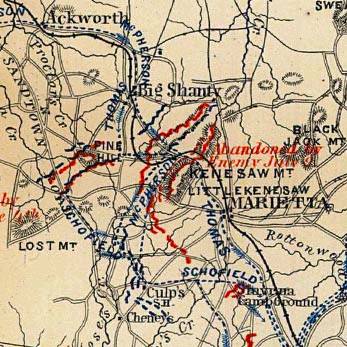 On
June 9th Federal troops pushed down the railroad as far as Big Shanty
(now Kennesaw) and Sherman established his headquarters there in the top
of a cotton gin from which he could view Kennesaw Mountain. He wrote,
"Kennesaw, the bold and striking twin mountain, lay before me. To our
right, Pine Mountain, and behind it in the distance, Lost Mountain. On
each of these peaks the enemy had his signal stations. The summits were
crowned with batteries, and the spurs were alive with men busy in
felling trees, digging pits, and preparing for the grand struggle
impending." Over the next two weeks, despite incessant rain, the Union
armies pushed Johnston's troops steadily back, first from the Brushy
Mountain line, then from Gilgal Church and Lost Mountain, Mud Creek, and
finally to the famous Kennesaw Mountain line. This six mile long series
of formidable entrenchments extended over Big Kennesaw and Little
Kennesaw Mountains on the Confederate right, Pigeon Hill, and Cheatham
Hill, to the Confederate left on the flatlands beyond. On June 22, Hood,
thinking he could turn the Union right, launched a disastrous assault on
Hooker's position near the Union center at Kolb's farm. The only thing
that saved Hood from total annihilation was the fact that Hooker timidly
neglected to follow up his success with a counter-attack. Sherman was by
this time totally frustrated with the slow progress of his armies, and
decided to attempt a full frontal assault on Johnston's positions,
hoping to crush the Confederate center. After days of artillery
barrages, Thomas sent five brigades forward to attack Cheatham's Hill on
the morning of June 27th. Three were concentrated on a salient later
known as the "Dead Angle" where brigade commander Gen. Daniel McCook was
killed attempting to rally his men. The well entrenched rebels mowed
down the Yankees in droves, with Federal casualties at the Dead Angle
reaching 824. An attack by McPherson on the entrenchments near Pigeon
Hill resulted in similar losses, and Sherman's assaults sputtered out by
noon. The Federal army had lost 3,000, including seven regimental and
two brigade commanders, and the Confederates lost only 600. Sherman
uncharacteristically aggressive attacks had been disastrous. He would
have to return to his masterful flanking maneuvers to get beyond the
Kennesaw line. On
June 9th Federal troops pushed down the railroad as far as Big Shanty
(now Kennesaw) and Sherman established his headquarters there in the top
of a cotton gin from which he could view Kennesaw Mountain. He wrote,
"Kennesaw, the bold and striking twin mountain, lay before me. To our
right, Pine Mountain, and behind it in the distance, Lost Mountain. On
each of these peaks the enemy had his signal stations. The summits were
crowned with batteries, and the spurs were alive with men busy in
felling trees, digging pits, and preparing for the grand struggle
impending." Over the next two weeks, despite incessant rain, the Union
armies pushed Johnston's troops steadily back, first from the Brushy
Mountain line, then from Gilgal Church and Lost Mountain, Mud Creek, and
finally to the famous Kennesaw Mountain line. This six mile long series
of formidable entrenchments extended over Big Kennesaw and Little
Kennesaw Mountains on the Confederate right, Pigeon Hill, and Cheatham
Hill, to the Confederate left on the flatlands beyond. On June 22, Hood,
thinking he could turn the Union right, launched a disastrous assault on
Hooker's position near the Union center at Kolb's farm. The only thing
that saved Hood from total annihilation was the fact that Hooker timidly
neglected to follow up his success with a counter-attack. Sherman was by
this time totally frustrated with the slow progress of his armies, and
decided to attempt a full frontal assault on Johnston's positions,
hoping to crush the Confederate center. After days of artillery
barrages, Thomas sent five brigades forward to attack Cheatham's Hill on
the morning of June 27th. Three were concentrated on a salient later
known as the "Dead Angle" where brigade commander Gen. Daniel McCook was
killed attempting to rally his men. The well entrenched rebels mowed
down the Yankees in droves, with Federal casualties at the Dead Angle
reaching 824. An attack by McPherson on the entrenchments near Pigeon
Hill resulted in similar losses, and Sherman's assaults sputtered out by
noon. The Federal army had lost 3,000, including seven regimental and
two brigade commanders, and the Confederates lost only 600. Sherman
uncharacteristically aggressive attacks had been disastrous. He would
have to return to his masterful flanking maneuvers to get beyond the
Kennesaw line. |

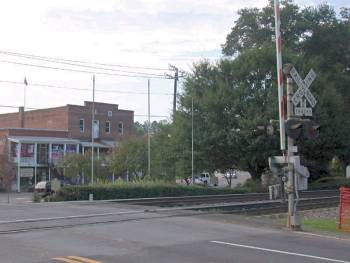
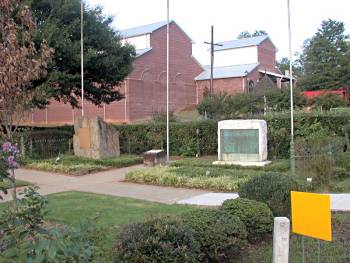
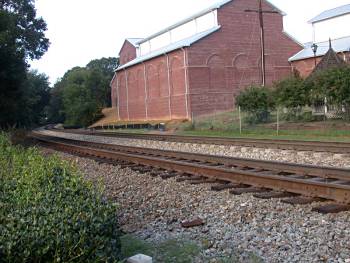
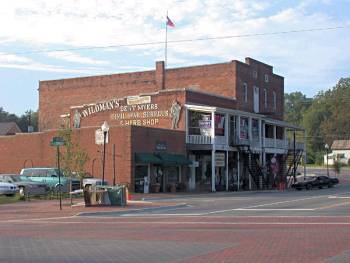
 On
June 9th Federal troops pushed down the railroad as far as Big Shanty
(now Kennesaw) and Sherman established his headquarters there in the top
of a cotton gin from which he could view Kennesaw Mountain. He wrote,
"Kennesaw, the bold and striking twin mountain, lay before me. To our
right, Pine Mountain, and behind it in the distance, Lost Mountain. On
each of these peaks the enemy had his signal stations. The summits were
crowned with batteries, and the spurs were alive with men busy in
felling trees, digging pits, and preparing for the grand struggle
impending." Over the next two weeks, despite incessant rain, the Union
armies pushed Johnston's troops steadily back, first from the Brushy
Mountain line, then from Gilgal Church and Lost Mountain, Mud Creek, and
finally to the famous Kennesaw Mountain line. This six mile long series
of formidable entrenchments extended over Big Kennesaw and Little
Kennesaw Mountains on the Confederate right, Pigeon Hill, and Cheatham
Hill, to the Confederate left on the flatlands beyond. On June 22, Hood,
thinking he could turn the Union right, launched a disastrous assault on
Hooker's position near the Union center at Kolb's farm. The only thing
that saved Hood from total annihilation was the fact that Hooker timidly
neglected to follow up his success with a counter-attack. Sherman was by
this time totally frustrated with the slow progress of his armies, and
decided to attempt a full frontal assault on Johnston's positions,
hoping to crush the Confederate center. After days of artillery
barrages, Thomas sent five brigades forward to attack Cheatham's Hill on
the morning of June 27th. Three were concentrated on a salient later
known as the "Dead Angle" where brigade commander Gen. Daniel McCook was
killed attempting to rally his men. The well entrenched rebels mowed
down the Yankees in droves, with Federal casualties at the Dead Angle
reaching 824. An attack by McPherson on the entrenchments near Pigeon
Hill resulted in similar losses, and Sherman's assaults sputtered out by
noon. The Federal army had lost 3,000, including seven regimental and
two brigade commanders, and the Confederates lost only 600. Sherman
uncharacteristically aggressive attacks had been disastrous. He would
have to return to his masterful flanking maneuvers to get beyond the
Kennesaw line.
On
June 9th Federal troops pushed down the railroad as far as Big Shanty
(now Kennesaw) and Sherman established his headquarters there in the top
of a cotton gin from which he could view Kennesaw Mountain. He wrote,
"Kennesaw, the bold and striking twin mountain, lay before me. To our
right, Pine Mountain, and behind it in the distance, Lost Mountain. On
each of these peaks the enemy had his signal stations. The summits were
crowned with batteries, and the spurs were alive with men busy in
felling trees, digging pits, and preparing for the grand struggle
impending." Over the next two weeks, despite incessant rain, the Union
armies pushed Johnston's troops steadily back, first from the Brushy
Mountain line, then from Gilgal Church and Lost Mountain, Mud Creek, and
finally to the famous Kennesaw Mountain line. This six mile long series
of formidable entrenchments extended over Big Kennesaw and Little
Kennesaw Mountains on the Confederate right, Pigeon Hill, and Cheatham
Hill, to the Confederate left on the flatlands beyond. On June 22, Hood,
thinking he could turn the Union right, launched a disastrous assault on
Hooker's position near the Union center at Kolb's farm. The only thing
that saved Hood from total annihilation was the fact that Hooker timidly
neglected to follow up his success with a counter-attack. Sherman was by
this time totally frustrated with the slow progress of his armies, and
decided to attempt a full frontal assault on Johnston's positions,
hoping to crush the Confederate center. After days of artillery
barrages, Thomas sent five brigades forward to attack Cheatham's Hill on
the morning of June 27th. Three were concentrated on a salient later
known as the "Dead Angle" where brigade commander Gen. Daniel McCook was
killed attempting to rally his men. The well entrenched rebels mowed
down the Yankees in droves, with Federal casualties at the Dead Angle
reaching 824. An attack by McPherson on the entrenchments near Pigeon
Hill resulted in similar losses, and Sherman's assaults sputtered out by
noon. The Federal army had lost 3,000, including seven regimental and
two brigade commanders, and the Confederates lost only 600. Sherman
uncharacteristically aggressive attacks had been disastrous. He would
have to return to his masterful flanking maneuvers to get beyond the
Kennesaw line.